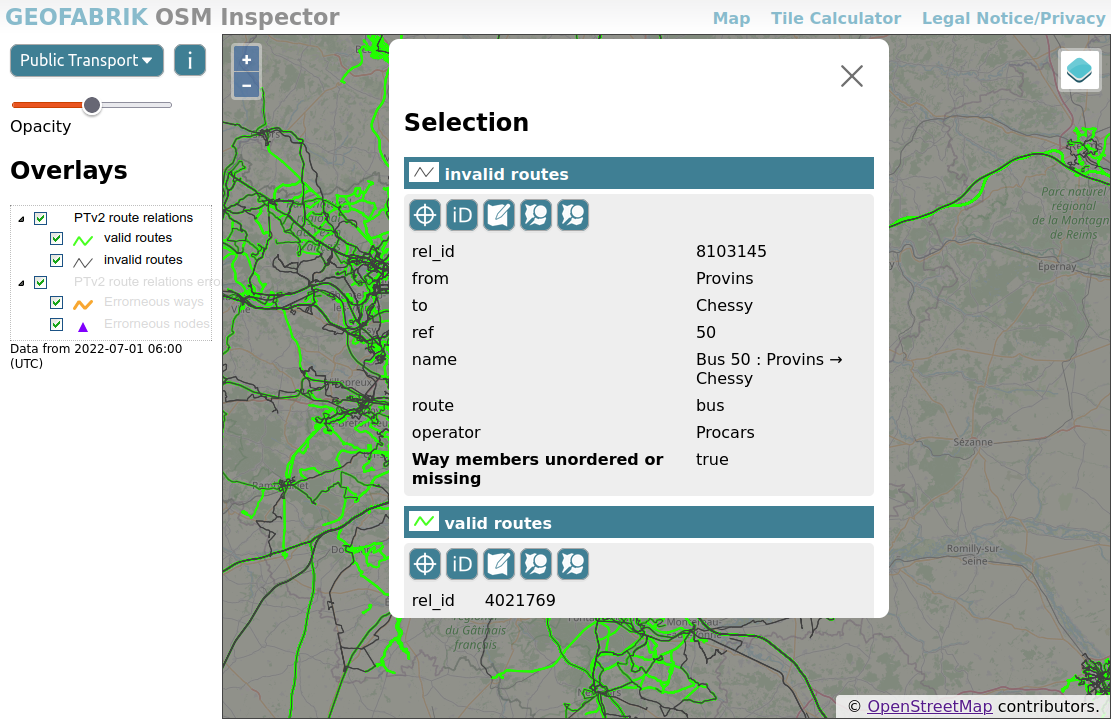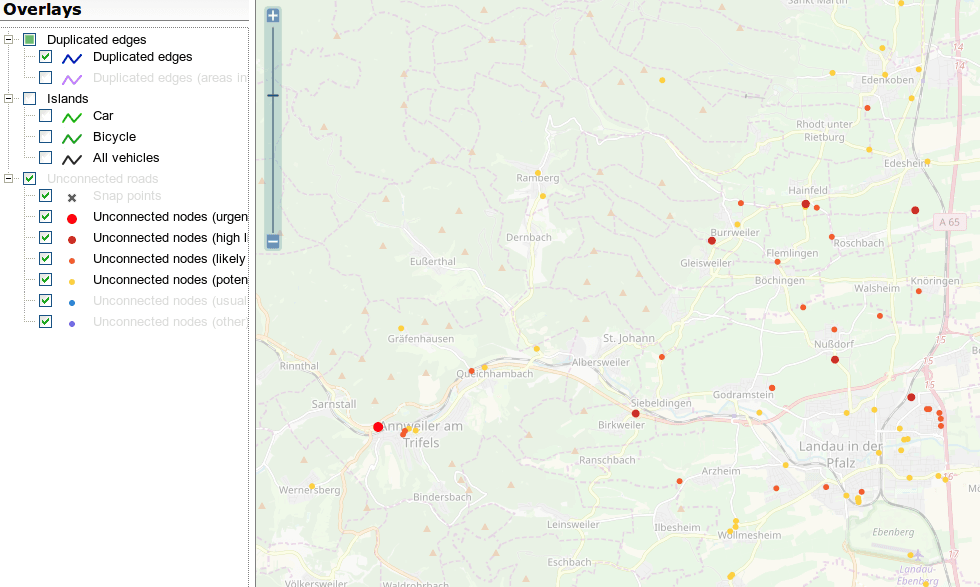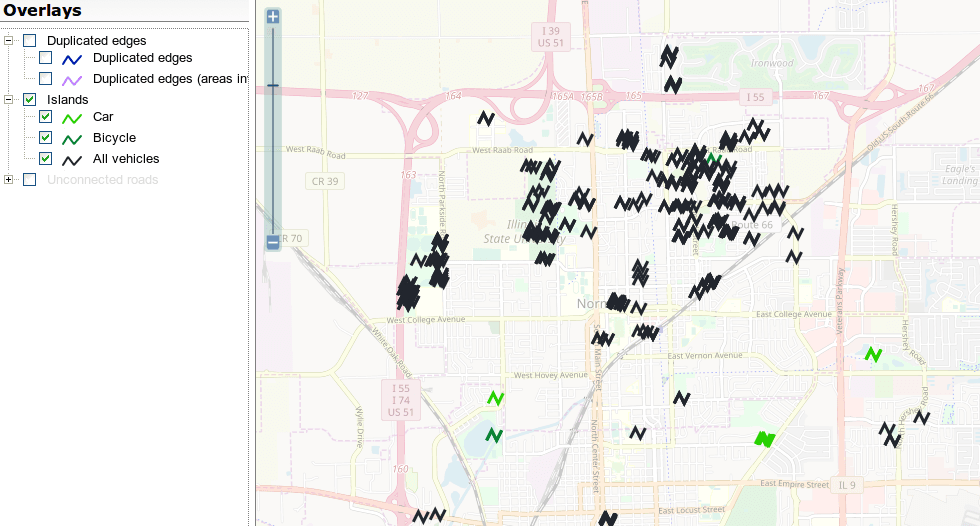
30.03.2023 | Frederik Ramm
We’ve started making vector tile packages available on our download server at download.geofabrik.de. At the moment you’ll find a .tar.gz file with vector tiles typically on the same level where you’d also find shape files — i.e. we don’t give you a package for all of Europe, but for individual European countries, and we don’t have a package for all of the US, but for individual states and so on.

These vector tiles use our Shortbread schema, and we create them with the excellent open source Tilemaker software. For suitable MapLibre vector styles, have a look at the VersaTiles repository.
This is supposed to be an experiment and we don’t yet make any promises about the structure and update frequency of this offer. We’re happy to hear your ideas though. At present, the .tar.gz files simply contain all vector tiles for the region as simple files (which are themselves .gz compressed so you might have to instruct your web server to add the appropriate encoding headers).
Like everything else on our download server, these tiles are made from OpenStreetMap data and come under Open Database License 1.0 with an OpenStreetMap attribution requirement.
29.03.2023 | Frederik Ramm
This weekend we’ll implement a change that affects the handling of boundary-straddling multipolygons in our OSM extracts. (See this 2017 blog article for some background.)
We’ll stop completing cross-border multipolygons except landuse polygons and a hand-picked list of natural polygons (e.g. water, grassland, wetland).
This has become necessary because of the propensity of OSM mappers to create huge multipolygons like “the Iberian penisula” or “the Alps”, artifacts that not only unnecessarily increase the data volume of any given PBF but also have unexpected consequences – for example, for a while anyone processing the rivers of the Switzerland extract would find a stretch of the River Danube in Vienna, because it happened to be part of the outline of the “Alps” multipolygon.
We hope that by restricting multipolygon completion to landuse and a small list of natural polygons we’ll be able to curb these unexpected side effects of polygon completion.
As a result of this change, the .osc.gz files generated on Friday night will contain “delete” operations for ways and nodes that were heretofore contained in the extracts due to multipolygon completion, but are not any longer.
Some data extracts, notably those for small islands or archipelagos, will shrink by more than 10%, but for most extracts the size will not be affected dramatically.
20.09.2022 | Michael Reichert
A few days ago we have added a couple of new road-related layers to our OSM Inspector.
highway=*In the past, highway=* was sometimes added to route relations (type=route + route=road). This is not in line with current tagging standards any more, and can even lead to duplicated line geometries when importing OSM data into PostgreSQL with Osm2pgsql.
The layer shows these old-style relations in dark red.
Not all relations with highway=* are a problem – for example, pedestrian areas and rest areas mapped as multipolygons relations (type=multipolygon) are totally fine and hence not shown as errors. This exception applies to multipolygons with a highway=* value of pedestrian, footway, service, rest_area or services.
Multipolygon relations with other highway=* values are likely candidates for changing to area:highway=*. See the OSM Wiki page aboutarea:highway=* for details about mapping roads as areas.
Even though OSM records “facts on the ground” and not historic or future data, it is generally accepted to map roads and paths which are not in use any more (or are not completed yet).
In recent years, the so-called Lifecycle Tagging Schema was adopted by many mappers and is used to tag feature which are not actively used any more, are (partially) removed or expected to be created in the future. The schema works by adding the lifecycle state as a colon-separated prefix to main key of the feature. If a road tagged as highway=secondary becomes disused, the tag is changed to disused:highway=secondary. Other tags of the feature remain unchanged.
(An older, but equally valid, way of describing lifecycle states is to put highway=construction together with construction=secondary. The new OSMI layers treat both methods in the same way.)
The following lifecycle sates are in use:
razed or dismantled or removed (note that the use of these prefixes is often subject to discussion and may be discouraged in your region)abandoneddisusedconstructionproposed (note that mapping proposed features may contravene the on-the-ground mapping rule and may be discouraged in your region)OSM Inspector now has four new layers displaying all linear highway=* features which are abandoned, disused, under construction, or proposed.
Two new layers render frequent mapping mistakes:
highway=construction without a construction=* tag), this is considered an error. Sometimes the correct tag value can be discovered from the object history; otherwise a survey is required.Please use quality assurance tools responsibly. They are often wrong. And even when they point you to poor mapping, simply repairing the mistakes is not a good choice. Poor mapping is often a sign of lack of knowledge (e.g. newbies), bad intentions, or mechanical edits, organised editing or imports gone wrong. It is worth having a look at an object’s history and other edits by the mappers involved to avoid simply “cleaning” the map and therefore possibly hiding a systemic issue. When contacting others about mistakes they have made, always remember that we all make mistakes and we can only become better by supporting each other.
1.07.2022 | Frederik Ramm
We have made a few small improvements to the OSM Inspector user interface, providing better responsiveness to different display sizes, using tiled WMS access for better performance, and improving the presentation of feature detail information.

Give it a spin at https://tools.geofabrik.de/osmi and tell us what you think!
5.09.2021 | Frederik Ramm
In the past night, a problem on the download server caused us to publish truncated data extracts for the following countries:
In Africa:
In Asia:
The extracts have been reset to yesterday’s version but if you have downloaded an extract between 2021-09-05 01:00 UTC and 2021-09-05 10:00 UTC then you have got a truncated file. Also, if you have an automatic process that loads daily updates, and you have loaded and processed an update for any of these countries in that timespan, you now have a truncated database and need to re-import data. (This will not automatically fix itself with the next update.)
If you have not loaded updates during this timespan, or if you have loaded updates but not for the countries mentioned, then you are not affected. (You are also not affected if you have used the full Africa or Asia files, these were correct.)
20.04.2020 | Frederik Ramm
In the last couple of weeks there have been two events that may have caused tile (or Nominatim) servers to stop updating. Here’s a quick outline on how to identify and repair the problems.
More …
14.06.2019 | Michael Reichert

We recently rewrote the OSM Inspector Routing View. The old views were used quite a lot by mappers to find potential routing errors. Unfortunately, they made use of PostGIS to find nearby, unconnected roads which meant having to import the whole road network into a PostGIS database every day. To make matters worse, the island and duplicate segment detection was implemented using OSRM which also has relatively heavy system requirements, especially if you do not limit yourself to automobile routing. This made us have a closer look at using GraphHopper to generate the routing view.
The new backend code was implemented from scratch and does not aim to be a one-by-one reimplementation. It uses GraphHopper to read the planet, build up the graph, analyse it and find nearby edges. Our code uses a forked version of GraphHopper 0.12 with the following changes:
OSMReader class. Our changes allow us to build additional indexes and populate maps mapping from internal edge or node IDs to OSM object IDs.PrepareRoutingSubnetworks class which removes islands from the graph is not extensible but we need to write the edges being removed to a GeoJSON file.In addition to forking, we implemented a new routing profile (“flag encoder” in GraphHopper speak) accepting any road and ignoring access restrictions. It is used to find duplicated edges, unconnected roads, and islands.
The backend code is available on GitHub.
The new routing view has the following groups of layers:
These layers show edges which exist twice in the graph. The blue ones are almost always real errors and should be fixed by comparing the tags and history of both ways. The purple ones are locations where two edges have equal geometry and at least one of them is an area. Opinions whether areas should share nodes with neighbouring roads are diverse among the OSM community. Therefore, these cases are shown in a separate layer at high zoom levels only.
The results of the duplicated edges layer (not involving areas) are similar to those of OSRM. Minor differences are possible where OSRM excluded a road due to access restrictions while our new implementation includes it.

The use of GraphHopper allows us to identify routing islands for multiple types of vehicles in one go. The OSM Inspector now provides islands for cars and bicycles using slightly modified version of the original profiles of GraphHopper (we use fewer bits to store the speed because island detection does not take travel times or distances into account). In addition, a layer with islands inaccessible to any vehicle is provided. This layer contains fewer entries in total but those contained are more serious because they are not caused by correct or incorrect access restriction tagging in OSM.
Most development time was spent finding a set of unconnected nodes layers with a proper separation of very likely, likely, potential errors and likely false positives. We are grateful to the folks on the German OSM forum who pointed out many bugs and too high rates of false positives.
Nodes where a single edge ends but with other edges within 15 meters are assigned to one of 6 priority classes. A distance below 2 meters makes a unconnected node appear in the top layer. The further composition of the layers depends on the road class, the distance, and access restrictions. The priority of unconnected nodes involving private access roads is reduced by 1. Service roads and footpaths get low default levels. In addition, the following rules avoid too many false positives:
noexit=yes and entrance=* make unconnected nodes disappear.The “snap points” layer shows the snap points of open ends helping to understand the situation.
Not all entries in the unconnected nodes layers are mistakes. Often, adding a linear barrier is helpful. The more blueish a point is, the less likely it is a mistake at all. Don’t feel forced to add noexit=yes to every point the OSM Inspector complains about. You are not mapping for the validator 😉
23.10.2018 | Christine Karch
Seit 2012 veranstalten wir zweimal bis dreimal im Jahr ein OpenStreetMap-Hackweekend in unseren Büroräumen.
Es wird am Freitag mit einem gemütlichen Abend in der Kneipe eingeleitet. Im Laufe des Abends trudeln die meisten Gäste ein. Viele haben eine weite Anreise hinter sich. Sie kommen aus allen Teilen Deutschlands, und oft ist auch der ein oder andere Gast aus dem Ausland dabei.
Von Samstag früh bis Sonntag abend geht es dann zur Sache. Es wird diskutiert, manchmal auch Flipcharts und Whiteboards vollgeschrieben. Dann wieder ist alles still, weil alle auf ihre Arbeit am Notebook konzentriert sind. Dazwischen unterbrechen wir unsere Gäste mit Pizza, Keksen, Gummibärchen oder Kaffee. Auch den Samstag Abend verbringen wir gemeinsam im Restaurant.
Aufgrund der Routine, die sich im Lauf der Jahre eingestellt hat, mussten wir dieser Veranstaltung zuletzt nur noch sehr wenig Aufmerksamkeit in der Vor- und Nachbereitung schenken. Die Wiki-Seite ist in zwei Minuten aufgesetzt (Copy und Paste vom letzten Jahr, die Termine werden angeglichen, die alten Teilnehmernamen werden quasi nur pro forma herausgelöscht). Wir recyclen sogar den alten Einkaufszettel.
Doch unser 16. Hackweekend stellte alles auf den Kopf. Ein zu Martin Raifer leicht dahingesagtes “wir können uns ja auf dem nächsten Hackweekend darüber unterhalten” verursachte ein 9-köpfiges Vorbereitungstreffen für die SotM in Heidelberg im nächsten Jahr. Und meine Bemühungen, den Austausch mit den Franzosen zu intensivieren, hatte Früchte getragen. Vincent Privat (aus Toulouse) machte Werbung auf der JOSM-dev-Liste. Sieben JOSM-Entwickler aus ganz Europa (von Österreich, über Polen und Belgien bis Frankreich) meldeten sich an.
Plötzlich war klar, dass die angemeldeten 32 Gäste überhaupt nicht in unser Büro passen würden. Glücklicherweise hat uns Prof. Dr. Günther-Dieringer ganz kurzfristig und unkompliziert einen Raum in der Hochschule Karlsruhe (University of Applied Sciences) vermittelt. Hierfür danken wir ihm alle ganz herzlich.
Am Ende war das Hackweekend wieder ein großer Erfolg. Auch diejenigen unter den Besuchern, die befürchtet hatten, dass alles nicht mehr so schön gemütlich sein würde, waren am Ende zufrieden. Der Karlsruher und Heidelberger Teil der SotM-Working-Group haben viele Fragen geklärt, den Zeitplan für das nächste Jahr aufgestellt und das Konferenzformat festgelegt. Ein Protokoll wird demnächst auf den Wiki-Seiten der OSMF zu finden sein. Auch die JOSM-Entwickler, die sich teilweise noch nie getroffen hatten, waren sichtlich produktiv und haben endlos Blätter auf dem Flipchart vollgeschrieben.
Wir freuen uns schon auf das nächste Hackweekend im Februar 2019!
4.05.2018 | Frederik Ramm
As mentioned two months ago, we have made some changes to our download server at download.geofabrik.de. The publicly available files now don’t contain user or changeset information any longer (see below for details). You can still get everything that was there before, but files that do contain user information were moved to a server that requires you to have an OSM login.
The public server continues to be download.geofabrik.de, and the URLs and paths have been unchanged. The new server that requires a login is called osm-internal.download.geofabrik.de, and while it looks largely the same as the public server, the files it offers will have a name component of -internal in order not to confuse them with the public files.
Here’s a table that explains which files to get where:
| public server | internal server | |
|---|---|---|
| .osm.pbf files for all regions (original OSM data) | yes, without user data | yes, with user data |
| .osc.gz files (diff updates) | yes, without user data | yes, with user data |
| .osh.pbf files for all regions (original OSM data with full history) | no | yes, with user data |
| .osm.bz2 files (old XML OSM data format) | yes, without user data | no |
| .shp.zip files for all regions (ESRI shape files) | yes | no |
The change was originally made on 03 May. Unfortunately osmosis and older versions of osmium, and all programs depending on them (e.g. osm2pgsql < 0.96.0) don’t work with PBF files lacking metadata fields. They fail to read PBF files which don’t have any username, user and changeset field set. To work around that, starting 05 May, we’re now writing empty strings to all user fields and zeros to all user and uid fields.
OSM extracs and diffs with full metadata are still available but you have to log in with your OSM account.
For security reasons, it is not enough to pick the cookie out of the developer console of your web browser. The cookie will become invalid after 48 hours and the server will redirect you to authorization form of openstreetmap.org if you send that cookie after it has expired. That’s why you have to retrieve a new cookie every 48 hours or any other time the server forces you to do so.
We have published a client program written in Python (read the documentation) automating the cookie retrieval. The repository containing the client also contains the server software if you are curious or want to use it on your own server providing sensitive data.
This blog post may be updated as things develop.
16.03.2018 | Frederik Ramm
On May 1st this year, we’ll make the following changes to the standard download.geofabrik.de server:
username, uid and changeset fields), and might* have their timestamp fields dilutedThe general functioning of the server and all URLs will remain unchanged. We believe that the majority of users of our download server, who use the extracts to populate rendering, routing, or geocoding engines, will not be affected by the changes.
In case you want to double-check if your software supports the files with missing fields, here are sample files for the UK county of Rutland with user data removed: osm.pbf, osm.bz2, osc.gz
If you need more test data, you can generate these files on your own using the latest (unreleased) Osmium Tool and the latest (unreleased) Libosmium library. The following Osmium Tool command removes all metadata except version and timestamp fields from a file:
osmium cat -o without-user-data.osm.pbf --output-format pbf,add_metadata=version+timestamp input.osm.pbf
(and similar for .osm.bz2 or .osc.gz)
At the same time, we will introduce a new service, osm-internal.download.geofabrik.de, which will be like the “old” download service, offering full history files, regional extracts, and diffs with full user information and un-diluted time stamps. This service will be 100% free of charge like the main download server, but will require an OAuth login with the openstreetmap.org web site and might* also require a click-through user agreement in order to safeguard personal data.
*) Some details are still being worked out.